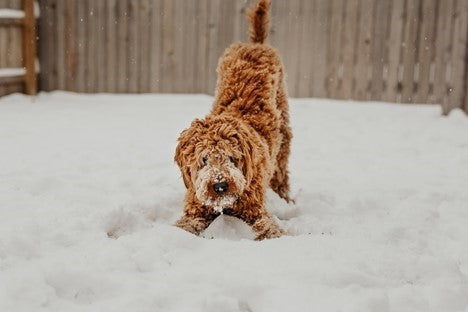Anxiety can be a hard thing to deal with in humans as well as your pets. Many dog owners think of their pets as furry kids, and they are! But we cannot forget that dogs are also animals with unique physical and emotional needs.
Dogs can get sick just like humans and they can also experience various mental and behavioral health issues as well. While separation anxiety is the most commonly seen, it is not the only cause.
It's important to know the common signs of dog anxiety, the behaviors, what they actually mean and how to help our furry loved ones!
Common Causes of Dog Anxiety?
- Loneliness or boredom – When dogs become bored or lonely, they may feel anxious. This is especially true if they have separation anxiety and feel abandoned.
- Changes in routine – A dog can become anxious if their routine or environment becomes altered or changed. For example, when an owner travels and does not come home at their normal time, the dog can become stressed out.
- Environmental triggers – A loud noise such as thunderstorms, fireworks, vacuum, doorbells, or even rowdy kids playing or fighting.
- Smell triggers - An overwhelming smell. Dog’s do not like menthol scents or harsh detergents, and some do not even tolerate diffusers or incense.
- Stranger danger - Dogs are keenly aware of their environments and can sense stressful situations with "people." The result could be a pet who fears anyone outside their pack. Or the dog is specifically fearful of children, men, or other pets.
- Painful experiences - Dogs subjected to abuse or mistreatment, in any way, may develop a painful condition called "learned helplessness." In learned helplessness, the dog fears harm even if he tries to escape.
- Travel – Traveling with your pet can be both exciting and rewarding for the entire family! But the change in environment and uncertainty of what is to follow can be incredibly stressful and create a sense of fear for our pets.
Warning Signs of Dog Anxiety?
Anxiety disorders in dogs are a little different from humans because our four-legged friends can't tell us what's wrong. Sometimes dogs may seem like they are simply being playful or excited. Other times, it is easy to see that something is wrong by how they behave. Here are some things to look for…
- Changes in your dog's behavior. This could be anything from more vocalization (barking, whining, howling) to destructive chewing or compulsive licking.
- Change in energy levels, either becoming more restless, pacing, or lethargic behavior.
- Changes in eating habits, either an increase or decrease in appetite.
If you suspect that your dog is suffering from anxiety, you should take them to the vet as soon as possible to rule out any underlying medical issues that may cause pain, discomfort, or emotional issues. In other words, something like an ear or tooth infection could be the reason they are appearing anxious.
Once you can rule out a physical cause, then you need to identify the source and triggers, so you can help them cope or treat their problem.
Identify Sources and Triggers of Dog Anxiety
Some things to consider:
- Knowing your pet’s history can help to identify if there are any mistreatment issues to consider and address.
- Identify any recent changes in your home or your dog’s living environment?
- Additional people, visitors, or small kids in the home
- Construction in the home, new paint, or carpet/flooring
- Moving décor around or your pet’s sleeping area
- Landscaping or new neighbors with pets
- Noise levels, such as loud music or machinery in or around the home
- Adding a new pet to the family
- Changes in routine?
- New job or school schedule that affects the amount of time you are with your dog
- Exercise schedule changes for walking or playing with your dog
- Diet or mealtime changes.
- Fear related behaviors.
- Is my dog bothered or fearful of someone in or near the home?
- Mail delivery persons, trash trucks, or gardeners
Helping Your Dog Overcome Anxiety Issues
There are a number of ways to treat anxiety in dogs, and the best approach will vary depending on the individual dog and the causes. Some common methods include behavior modification, desensitization and counterconditioning, medication, and natural supplements.
- Behavior modification involves changing the way you interact with your dog to help them feel more comfortable and relaxed. This could involve something as simple as not making a big deal out of comings and goings, or it could require more commitment, such as attending training classes together.
- Desensitization and counterconditioning are two techniques that can be used together to help your dog overcome their anxiety. Desensitization involves gradually exposing your dog to the thing they're afraid of, starting with very small exposures and working up to longer periods of time.
- Counterconditioning is teaching your dog to associate the thing they're afraid of with something positive, like treats or love and attention. Try Health Extension’s Dog Treats to enhance your counterconditioning training with your fur baby. They will thank you for it!
- Natural supplements have been shown to be effective in treating anxiety in dogs. Health Extension has a natural remedy called Stress Relief to help reduce the physical effects of your dog’s stress and anxiety levels. This product can be given orally or added to your dog's food.
- Medication can be an effective treatment for anxiety in dogs, but it's important to work with your vet to find the right medication and dosage for your dog. Medication should always be used in conjunction with behavior modification and training, not as a replacement for it.
Anxiety in dogs can be managed and treated, making life much easier for both the dog and owner. If your dog is experiencing anxiety work with your vet to find the best approach for your dog, and don't forget that patience and consistency are key! What have you found to be the most helpful when managing your dog’s anxiety?



